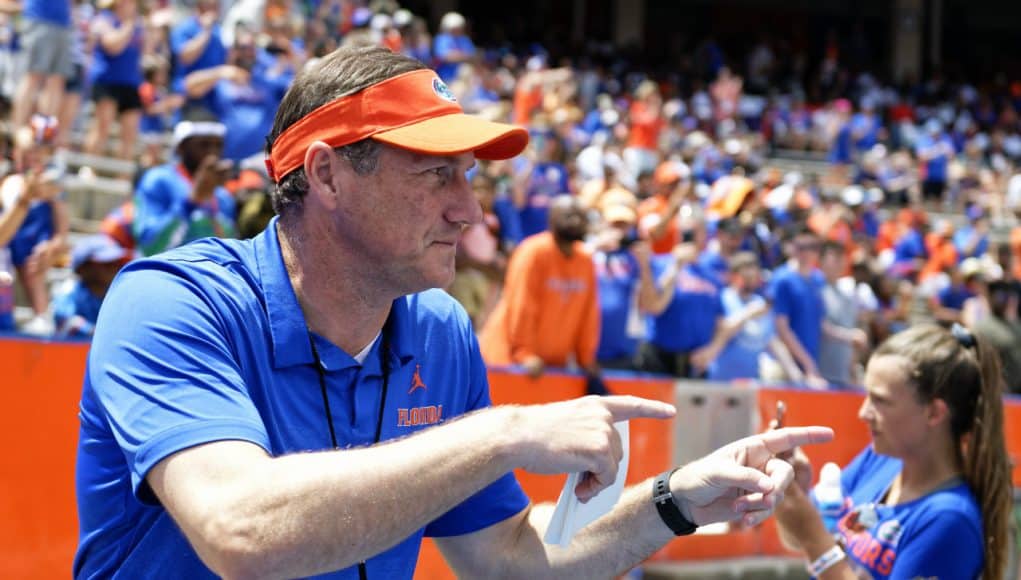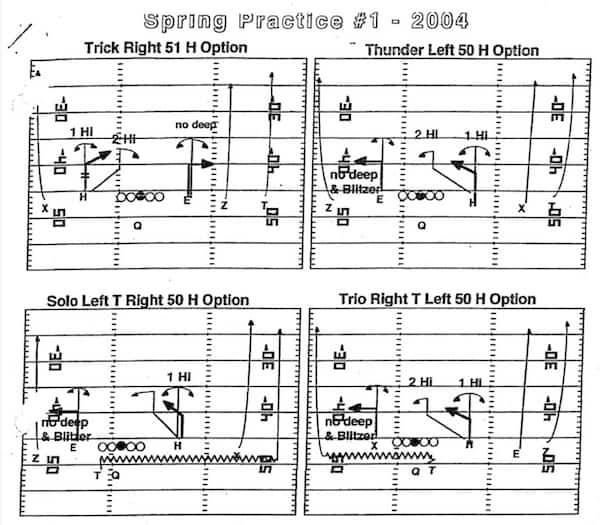Last offseason, I went through some of the basics of Dan Mullen’s offense — using spread and option to run, running against two-high safety looks, personnel groupings, and play calling through a full game.
Today, I’m going over one particular play: H Option. I used Coach Barry Hoover’s explanation of the play as a starting point, but he goes into a high level of detail without many affordances for those who aren’t familiar with a lot of football jargon. I’ve simplified things here, so I’d recommend going to his post after you’re done with this one.
H Option is a play from the Urban Meyer/Dan Mullen offense that goes back at least to their days together at Utah, and it’s one of their more distinctive ones. Hoover notes that, at least of his writing in 2012, not many other programs ran it. Yet, in the 2004 Utah playbook, H Option is the first offensive play of the Day 1 installation. Let’s dive in.
Option Routes
You might guess from the name that H Option is a run play. After all, the “option” in “spread option” does refer to run options.
In fact, H Option is a pass play. It gets its name from the H receiver running an option route. What is an option route? Here is a good explanation with pictures and video from the site Inside the Pylon.
In short, though, an option route is one where the receiver has to make a choice on where to go based on the defense. The answer may be in the initial alignment of the defense, but it can also hinge on whether the defense is in zone or man coverage and/or whether the receiver’s defender gives up the inside or outside track.
For option routes to work, both the receiver and quarterback must read the defense the same way. If they don’t, it can lead to a bad misfire or pocket indecision from the quarterback.
As with a run option, option routes are designed to never be wrong. The idea is that if you can read the defense and decide after it has committed to what it’s doing, you can always put the ball where the defenders aren’t. In practice, it doesn’t always work that way. A common way to try to defend option routes is to confuse the receiver and force him to make the wrong choice. Still, option routes can be deadly when the quarterback and receiver are on the same page.
H Option Basics
Image of H Option variants from 2004 Utah playbook
Since we’re long past the days of Vince Lombardi and the power sweep left or right making up the lion’s share of an offense’s attack, H Option can take on a variety of manifestations from different formations. Maybe the running back goes in motion, or maybe he starts out wide.
Here’s the bedrock premise, though: it’s a five-wide formation with three clear-out routes and two option routes. The primary target is the slot receiver H, and the second option is an outside receiver. H will run a short pattern to the middle unless it’s taken away, and if it is, he’ll go a bit deeper and cut inside or out. The secondary target will run a short out if possible with a longer in-or-out decision to be made if it is taken away. The other three receivers will run vertical routes to clear out the underneath area.
The ideal is to get the ball to H as quickly as possible. He should be a dynamic player who’s great at making sharp cuts and is dangerous in the open field. During Mullen’s first tenure at UF, Percy Harvin was the man for the job.
The running back is not the first or second option on this play, but he’s important nonetheless. Whether he lines up out wide or motions there, he presents the defense with a dilemma. By putting the back out widest, he ends up in a spot where a corner typically does the pass defense. But, wasting a corner on a running back who’s unlikely to get the ball is not great, and it means a linebacker will probably end up covering the slot man.
Should the defense put a linebacker on the running back instead? Linebackers aren’t accustomed to playing out there. Doing so would open up the middle for H anyway, or it could induce the offense to audible into a run. The defense could use a safety on him, but that would eliminate two-high safety looks. All of these considerations are relevant for any play that puts the running back out widest to one side, which is why Mullen does that on more than just H Option.
Putting It in Motion
With the offense focused on execution of the basics and the defense largely handcuffed, the 2019 Orange and Blue Game was a good opportunity to clearly see H Option on the field. I put together a video for you to see three incarnations of it.
In the first one, Kadarius Toney is in the H spot. It’s a good play for him as he’s the most Harvin-like of the receivers. He takes the quick slant because that’s what James Houston gives him, but the ref ends up in the way and messes up the play.
In the second one, Freddie Swain is in the H role. Rayshad Jackson takes away the quick slant, so Swain goes behind him to the deeper level. After Swain does a quick cut in, Emory Jones hits him for an easy completion. This one features a wrinkle in that the running back Iverson Clement cut his route off early to draw Jackson towards the sideline rather than run a full vertical.
In the final one, Jackson is lined up on Swain but Ventrell Miller is patrolling the middle of the formation as well. I think Jones makes the presnap read to look outside as a result, even though Jackson and Miller end up moving a little towards the two sidelines in zone coverage and opening up a pocket for Swain. Jones, who is looking outside the whole way, I think is trying to hit Tyrie Cleveland on the near sideline. However, Luke Ancrum bull rushes Michael Tarquin enough to get a hand up and bat down the pass.
Even though two of these three instances don’t result in a completion, I think they offer a good sampling of how the play can work. Two of them have H to the left while the other has H to the right. They feature formations with zero, one, and two tight ends. They have throws to the quick slant, the longer H option route, and to the outside.
This year, we’ll see Toney and Swain in the H position. In the future, it might well be Jacob Copeland. Whoever it is, it’s a play that you won’t see from many places other than Florida, but the Gators will be running it to success.



